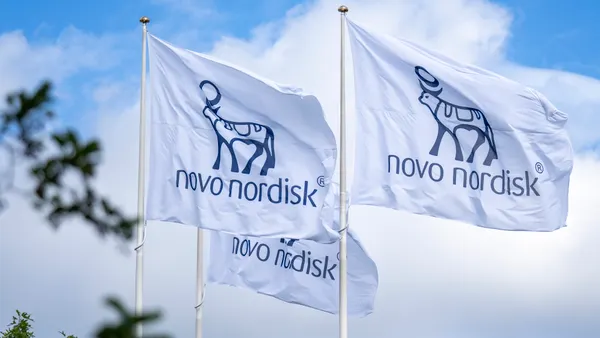Drug Development Strong Clinical-Trial Management Systems Market Offers Opportunities for suppliers, Clinical Sponsors, and CROs Alike The U.S. clinical-trial management systems (CTMS) market is poised for steady growth through 2008, achieving a five-year compound annual growth rate (CAGR) of about 13%, a new research study from Life Science Insights reveals. Analysts expect the market for CTMS software licenses to grow during the same forecast period, from $193 million to $360 million. While component technologies, such as EDC, play a major role in these markets, systems designed to manage multiple aspects of clinical-trial management will drive adoption of CTMS among pharmaceutical and biotechnology companies. For similar capabilities, such as automating trial processes, increasing the efficiency of trials, and managing operations better, academic and government institutions will look to CTMS. According to the study, CROs will select applications providing a complete range of functions that these organizations can use to create greater efficiencies for outsourced clinical trials. Life Science Insights’ study, U.S. Clinical Trial Management System 2004-2008 Forecast and Analysis, illustrates that clinical-trial sponsors will increasingly seek to optimize the clinical-trial process by moving to fully functional CTMS. Successful providers will mature their systems with cross-functional features able to meet growing integration needs. Additionally, providers must offer sponsors the opportunity to save in management costs with a lower total cost of ownership compared with homegrown, disparate systems. Providers able to deliver these applications at lower prices could turn the tables on current market leaders. “The market for CTMS is still relatively immature,” says Judy Hanover, research analyst. “Current market leaders cannot afford to become complacent as this market evolves because leadership and market-share positions remain in flux.” Source: Life Science Insights, an IDC company, Framingham, Mass. For more information, visit life-science-insights.com. Suppliers must offer sponsors the opportunity to save in management costs with a lower total cost of ownership compared with homegrown systems. Boily. Developing a drug is like walking on a tightrope blindfolded. Drug development takes between 10 years and 15 years and costs upward of $800 million per drug, yet only 8% of all drugs in development ultimately receive FDA approval, according to FDA Commissioner Lester Crawford. New financial models will be required to share the significant costs and associated risks involved in bringing new drugs to market. Cauwenbergh. The increased investment in R&D at the private and public side is an illusion. It is true that more money has been spent in those departments. The increased spending, however, primarily has covered increased overheads. Why is it that the fully loaded cost of a full-time equivalent (FTE) is about $100,000 per year lower in small pharma compared with big pharma? Watering the lawn and feeding the ducks in the pond also costs money and the overall cost of a heavy corporate overhead structure in big pharma contributes significantly to the difference. The increase in spending is in part also justified by the increased costs in areas such as regulatory, QA, compliance, legal costs, and IP protection. The FDA looks at fewer NDAs because big pharma submits fewer NDAs. That is because the financial machinations that go behind a development decision look at constantly increasing NPV requirements because of increasing internal costs: overheads. Drugs that take seven years to complete development and that have annual sales potential of $400 million don’t make the cut in big pharma. To overcome these obstacles, companies need to question the relevance and validity of some of the regulatory interferences. They also need to stimulate controlled patent life extensions. Why is it that Mick Jagger (or his relatives) continue to get author right payments on “I Can’t Get No Satisfaction” for a period of 50-plus years, whereas scientists see the time span they have to profit from their brain child reduced to less than 10 years as a result of extended development times? Patent life extensions could be considered in lieu of accepting price control measures after the initial patent life has expired. Big pharma companies need to realize that they are what they are: big financial institutions, the keepers of large IP portfolios and massive global sales, marketing, and distribution machines. They need to be convinced to stay out of R&D, and only fund it, either in separate companies or in an internal environment unencumbered by the nonsense of inflated corporate overhead spending. Peacock. The pharmaceutical and biotech industries will share many of the same challenges in the coming year. Perhaps the biggest issue facing our industry is R&D and depth of pipelines, from a financial/business consideration and from a patient-treatment point of view. With each new NCE costing from $500 million to $1.6 billion to bring to market, companies have to scrutinize each opportunity more than ever before. In addition, each new compound needs to be evaluated to determine if the investment can be maximized across a range of indications. As in the past, in 2005 and beyond, our industry will continue to be challenged to innovate, to bring the ideas developed at the bench to life as medicine, and to deliver on the exciting discoveries taking place each year in laboratories across the globe. Barrett. As a major cost center for research and development, clinical trials are affecting the bottom line. So, companies are continually looking at ways to streamline how they successfully complete trials to increase the profits their shareholders realize. This requires better use of the technology now available to the industry. Freiman. The biggest challenge is to find meaningful new products that are not just incremental differences from their competitors. I believe the amount of money spent on research by big pharma has not been commensurate with the results. It is difficult to develop new drugs effectively when research layers of management have proliferated and decision making becomes secondary to turf wars within a company’s portfolio. More and more companies would be better served by working collaboratively with smaller biotech companies that can provide the same good science without the bureaucracy of larger organizations. Drakeman. The rate of approvals for new biologic products has been growing over the last decade as monoclonal antibodies and recombinant proteins have hit their stride. In preparing for the future, it is critical to adjust to the new pattern of biopharmaceutical development, from large-molecule research to protein manufacturing and specialized salesforces for targeted therapeutics. Muyot. The big pharma multibillion-dollar research and development budgets (estimated at more than $50 billion in 2005) have been hard pressed to continue the trend as the industry matures. The life-sciences industry is undergoing a paradigm shift in which there will be winners and losers. Organic company growth has given way to outsourcing, licensing, joint ventures, and strategic alliances. The growth areas for the next 10 years will be focused on specialty markets. Advancements in technology and materials have opened up new opportunities in drug delivery, large-molecule drug development, medical technology, and diagnostics. Xanthopoulos. There is a lot of pressure from investors to deliver approvable products as quickly as possible. A lot of investors don’t want to wait the 10 years to 14 years it takes to develop a drug from scratch. Furthermore, many investments in new technologies and infrastructures in recent years have not yet begun to deliver on their promise or impact the productivity of the pipeline. This is driving the trend toward quick-fix solutions to fill pipelines, such as tweaking products to extend patents and licensing products from other companies rather than developing products organically. Licensing is critical to pipeline building, but unless pharmaceutical companies also devote resources to internal drug-discovery programs, there won’t be many quality opportunities to license in the near future. W. Levy. Many companies have insufficient product pipelines, as well as near-term patent expirations on leading products. Costs continue to rise while the public is clamoring for reduced drug prices. The regulatory approval process is long and lacks consistency from country to country. Increased manufacturing costs are addressed by relocating facilities instead of developing technological advances to manage costs. The companies that are successful will develop strategies that address these factors. Carabello. Inaccurate study modeling and delayed patient recruitment translate into lost revenue in the hundreds of millions of dollars, per drug. Pharmaceutical companies and their affiliates continue to rely upon traditional marketing tactics and media campaigns that are not only costly and time-consuming, but also act as a continuous drain on the patent clock. Smarter use of available healthcare data can build value by bringing products to market more rapidly and allowing companies to more quickly recoup R&D costs. Young. As the number of clinical trials escalates there is increasing competition for the same patients. This is at a time when the trial requirements are becoming even more stringent. Karczewski. One of the major challenges facing the industry is weak drug pipelines. Interestingly, much of the research today is coming from small- and medium-sized companies, so big pharmaceutical companies are looking to acquire products and companies with promising compounds. The lack of drugs in the pipelines means everyone loses. Pharmaceutical companies are scrambling to fill the void and find ways to increase corporate profits. Suppliers that help market new drugs — from healthcare agencies to medical publishers to medical-education firms — are looking at a shrinking marketplace and decreasing income. W. Thompson. Clinical testing is the challenge as it grows more extensive and expensive. Results are often equivocal. Diseases are multifactorial and single agents may have small marginal benefits in a fraction of the patients who may be difficult to identify in advance. McNamara. Pharmaceutical companies are spending enormous amounts of money on clinical-development programs and often have little to show for those investments. The key to this challenge lies in obtaining better clinical data earlier in the drug-development process. As a result, ineffective clinical programs can be adjusted or stopped sooner and effective clinical programs can be accelerated. The question is, are companies doing everything in their power — using all the tools available — to collect clinical data in the most accurate and timely manner? In many cases they aren’t and this has to be fixed. Pharmaceutical companies, IT providers, clinical investigators, patient advocates, and the federal government all need to work together to ensure patient safety, reduce costs, and improve productivity and data collection so that new and effective drugs can be brought to market more efficiently. beh Swan Gin. In the short term, some pharmaceutical companies are responding by extending the life cycle of their existing drugs through new indications or novel combination therapies. Pharmaceutical companies also are casting their nets wider to seek novel ideas, products, and fresh insights to improve the productivity of their drug-discovery processes. In the long term, companies need to improve the productivity of their drug-discovery and development processes. In addition, there has to be a review of the regulatory requirements to make it less onerous, without sacrificing patient safety, for the development of new therapies. Biomedical companies, scientists, doctors, healthcare providers, and payers need to come together to figure out how to apply the many new scientific and technical tools, including assays, in silico solutions, biomarkers, and clinical-trial endpoints to make the clinical-development process more efficient, effective, and safe. W. Thompson. Acute simple diseases have lots of therapies. The complex multifactorial diseases take much more work and the industry should expect only marginal benefits. This will not get better as we have witnessed since the bloom of genomics/molecular biology. The industry has far more discoveries than it can develop. Expectations must become more realistic. Carabello. Looking longer term, there is a major challenge in expanding clinical-trial capacity. Because of the recent discovery of the genome, the number of drug targets in the human body is predicted to increase from 4,500 to about 10,000. Surging innovation will produce surging demand for clinical-trial capacity. Demand soon will outstrip the capacity of the current trial infrastructure, supported by less than 5% of physicians (as investigators) and fewer than 1% of patients (as trial participants). Data-driven processes are well-suited to identify which physicians are likely to become effective investigators, and who/where the patients are with combined conditions that make them good candidates for trials. Sulkes. There is a great opportunity for academic tech-transfer programs to send more early-phase compounds to the commercial sector. Additionally, there is a need for pharmaceutical and device companies to invest in a broader range of new compounds. For these events to happen, there needs to be a reduced price associated with risky early-stage compounds as well as a more cost-effective way to run early trials and gather required data. In the immediate short term, the industry should support efforts to provide distance learning for clinicians, investigators, nurses, patients as well as clinical-trial management approaches to enable a larger number of compounds to move forward. Kovac. As information technology’s role in pharma grows at an exponential rate, one of the main challenges the industry faces is identifying which technologies are a prerequisite for making targeted treatment solutions and which are essential for managing processes in the interim. In other words, on what technologies should pharmaceutical companies be spending their money? Shanahan. In life sciences, the current approach of connecting lab informatics silos to accelerate R&D is at a point of diminishing returns. Storing valuable lab information in office document formats, restricting collaboration through rigid lab databases, and relying on IT programming to support new projects are failing propositions as the margin pressure on R&D continues. R&D productivity can break through the current lab informatics barrier only when a flexible software solution supports the entire life cycle of lab research and closes the loop between design, experimentation, analysis, and reporting. Carabello. The pharmaceutical industry will continue to invest an exorbitant amount of capital and human resources into patient recruitment. Whether results improve depends on whether the industry adopts new approaches, such as the use of aggregated healthcare data. Rather than relying so predominantly on traditional marketing-driven recruiting methods, a data-driven approach would enable the industry to more accurately and rapidly develop clinical-trial study models and protocols as well as to initiate and complete the patient-recruitment process. The old ways are time-intensive and consume significant funds; new data methodologies help sponsors reach their endpoints faster, with better targeting and more control of risks and outcomes. The increased availability of managed-care data is significantly changing the landscape for today’s R&D professionals. Zeldis. Dealing with the journal editors’ demands for public databases that discuss on-going and completed trials is now a challenge. While straightforward in concept, the devil is in the details. For example, if the database lists the results before publication of the t ial in a peer-reviewed journal, will a journal refuse to publish the manuscript because of “embargo” rules? Investigations will be disclosed to the public and this could lead to increased interactions/distractions from the external audiences. If the time of last patient visit and the time of database lock are listed (as demanded by the editors), will this lead to unfair benchmarking of the pharmaceutical companies by analysts and others? s. levy. Regulatory bodies and other stakeholders are demanding greater disclosure of all clinical trials conducted to research pharmaceuticals. Whereas in the past a clinical trial was considered the private property of the pharmaceutical company that sponsored it, if many groups get their way, trials and their results will be disclosed in a comprehensive public database. Many players, such as New York’s Attorney General Eliot Spitzer, medical journal editors, physician groups, and several members of Congress, are lining up to make this a new reality for drug companies. Pharmaceutical companies are leaning toward self-regulation on this matter and are hoping that voluntary databases of clinical-trial information will suffice. Whether voluntary or under federal mandates, pharmaceutical companies will be forced to disclose more information about their clinical trials, and this will have implications on strategy. Clinical-trial programs can highlight a company’s market-launch strategy, and this strategy will be made public for the first time in 2005. In theory and in practice, competitors will be able to study each other’s trial designs and results, revealing safety and efficacy data early, as well as the company’s life-cycle plans for future indications. Being the first-in-class in the industry will no longer be a strict advantage, as additional disclosure will allow late fast followers to learn from the mistakes of innovating companies for the first time. Also, there may indeed be fewer, but more successful, new studies since pharmaceutical companies will learn collectively which trial protocols succeed or fail. The pharmaceutical industry will face interesting choices in 2005, because transparency is here to stay, but so is privacy, at least in 2005. What’s Your Opinion? 2005 — A look ahead What are the most significant business challenges you believe the industry will face in 2005? The model needs to evolve Many issues face the industry in the near term, including the possibility of price controls, importation, and maintaining an innovation-friendly environment. There is, however, a large structural issue that needs to be overcome before the environment will change for the better. The computer-chip industry faced a similar type of structural issue. That industry prospered for decades on a model of ever-faster chip speeds, until the incremental gains in speed no longer yielded increased productivity and growth slowed. While speed is still important, the model now is to produce multifunction chips that do more but operate with the least amount of energy necessary. For the last two decades, the pharmaceutical industry has worked under the “blockbuster theory,” and new agents had to be in high-incidence disease states, such as hypertension, allergy, or depression. But, like the chip industry, the model has changed. The possibility of continually developing a blockbuster in the big categories has diminished as continual therapeutic advances have yielded a wide variety of very effective drug choices. Thus, the model needs to evolve to discovering agents in multiple specialty disease states where there are fewer options. The number of newly approved drugs is at an all time low and the corresponding loss of patent protection for many products will put pressure on companies as they try to maintain profits and shareholder value, while facing tremendous scrutiny about raising prices on in-market products. This may lead to more consolidation and/or more collaborations and alliances. The challenge will be in weathering the storm while the innovation model transforms to focus on more targeted disease states as well as completely new discoveries. Gregory Young NeoPharm Inc. As the number of clinical trials escalates, there is increasing competition for the same patients. This is at a time when the trial requirements are becoming even more stringent. Dr. Douglas Kolodny-Hirsch Chesapeake PERL Inc. The need to balance financial risk in the face of growing demand will drive the industry to outsource protein manufacturing and other core competencies. This bodes well for contract manufacturing organizations with spare capacity and innovative platforms. Matthew Shanahan Teranode Corp. In the field of life sciences, R&D efficiency continues to climb with advances in lab automation and data analytics, but the productivity and number of drug approvals continues to decline. The paradox of the situation is confounding many organizations as they struggle to improve. Laura Carabello iTrials Rather than relying so predominantly on traditional marketing-driven recruiting methods, a data-driven approach would enable the industry to more accurately and rapidly develop clinical-trial study models and protocols as well as to initiate and complete the patient-recruitment process. Guy Dess, President, Adient, part of CommonHealth Dr. Warren Levy Unigene Laboratories Inc. A rational policy must be developed for testing and approving products that are identical to existing products except that they are made using biotechnological processes. For too long, biotech products have been treated differently from products made by any other technology. Tactics to Reduce Development Cycle Times Bringing candidate compounds to market faster is a challenge that the industry has been wrestling with for more than a decade. While there is no silver bullet, there are a range of tactics that can be employed to reduce the overall clinical-development cycle time. Without aligning the organizational structure to new operations, unnecessary handoffs and turf battles can result in a loss of time savings. Gary Tyson Campbell Alliance Target the indication. Given the cost and risks associated with clinical trials, the natural tendency is to try to gather as much evidence on as wide a range of endpoints as is feasible. This reduces risk; if one endpoint fails to show benefit another may prove useful. But this approach can be unwieldy and result in complex protocols often with highly restrictive patient inclusion/exclusion criteria. Instead, it is best to keep endpoints focused and protocols simple. Assume a patient-recruitment crisis. While it is common knowledge that patient recruitment is the single-most common cause of delays in clinical trials, few study managers apply aggressive patient-recruitment practices until a problem becomes apparent. While this approach may seem to avoid overreacting, in reality it allows time for a patient-recruitment crisis to develop. Organizations that begin with the assumption that there will be a problem are much more effective at preventing one from occurring. Reduce time by leveraging technology. The primary value of new electronic data management (eDM) technologies should be to reduce the overall clinical-development cycle time. If implemented correctly, eDM should shave weeks off the back end of the study, leading to either faster start up of the next phase study or earlier submission. Electronic submission should reduce submission readiness time as well. A well-implemented eDM plan will speed clinical development. Apply the Right Resources. All the changes discussed above demand a new approach to staffing clinical-development organizations. Yet, despite these and other major changes implemented in clinical development, few organizations invest the time and political will power necessary to restructure their organizations to capitalize on these changes. Without aligning the organizational structure to the new operations, unnecessary handoffs and turf battles can result in a loss of time savings. Source: Campbell Alliance, Raleigh, N.C. For more information, visit campbellalliance.com. Content Management Providers May Challenge Growth for PLM’s New Product Data-Management Strategy Product life-cycle management (PLM) has had a slow start despite its potential to create operational efficiencies in the life-sciences market. Enterprise resource planning (ERP) is likely to provide the necessary impetus for the PLM industry to take off successfully, according to Frost & Sullivan. The report, PLM Markets for Life Sciences, reveals that revenue in this industry totaled $38.3 million in 2004 and is projected to reach $48.8 million in 2007. “There is a move to position PLM as the backdoor extension to enterprise ERP,” says Amith Viswanathan, research manager at Frost & Sullivan. “Since 45% of life-sciences companies already have a current or a legacy ERP system license, conversion to PLM is the natural next step.” License restructuring and add-on discounts are expected to become a key part of the penetration strategy for PLM providers having an ERP presence. Once PLM gathers pace in the life-sciences market, there are possibilities of fusing it with ERP systems to form a unified solution that eliminates complicated and expensive integration procedures. But ERP’s existing links with data-management systems may create a cheaper solution for customers and bypass many of PLM’s similar application sets. Faced with this challenge, PLM providers need to consider out-of-the-box solutions wherein they focus on core application sets and use flexible integration software to win business. There are still chances of encountering integration roadblocks in these out-of-the-box solutions. For instance, the bulk of the integrations between dissimilar PLM and ERP applications requires conversion software. Not only does this add extra layers to an already bulky infrastructure, but it can lead to conversion errors and data migration problems. “For such larger installations, the market is likely to continue to rely on conventional integration channels that add heavy premiums to PLM prices,” Mr. Viswanathan says. Providers must also be ready to face competition from content management (CM) providers seeking to expand their presence in the enterprise applications markets. Regulatory document management, in particular, is a prime candidate for competitive entry. Warding off competition from CM providers is likely to be a potentially difficult task. This is largely because current and legacy CM systems are used in more than 70% of the life-sciences market. This gives powerful leverage to established players to expand outward into specific data and document management niches, such as manufacturing, clinical trials, and resource planning. “If larger CM providers decide to compete, PLM companies could have a serious issue on their hands,” Mr. Viswanathan says. The threat posed by CM providers is expected to be greater for PLM companies striving to make inroads in the process engineering segments, such as biotechnology and pharmaceuticals. CM providers are likely to adopt aggressive strategies to maintain their dominance. They are already adding tools that resemble PLM, for example document archive and authorization and e-room collaboration. Although PLM is highly undersold in process engineering industries such as pharmaceuticals, 2005 is anticipated to witness profound changes in the way PLM is perceived in more discrete manufacturing industries, such as medical devices. “PLM is moving to add value to logistical efficiency goals that are coming sharply into vogue among management circles, such as just-in-time inventory planning,” Mr. Viswanathan says. Source: Frost & Sullivan, Palo Alto, Calif. For more information, visit healthcare.frost.com. 2005 is anticipated to witness profound changes in the way PLM is perceived in more discrete manufacturing industries, such as medical devices.
An article from


Drug Development
Filed Under:
Research & Development










